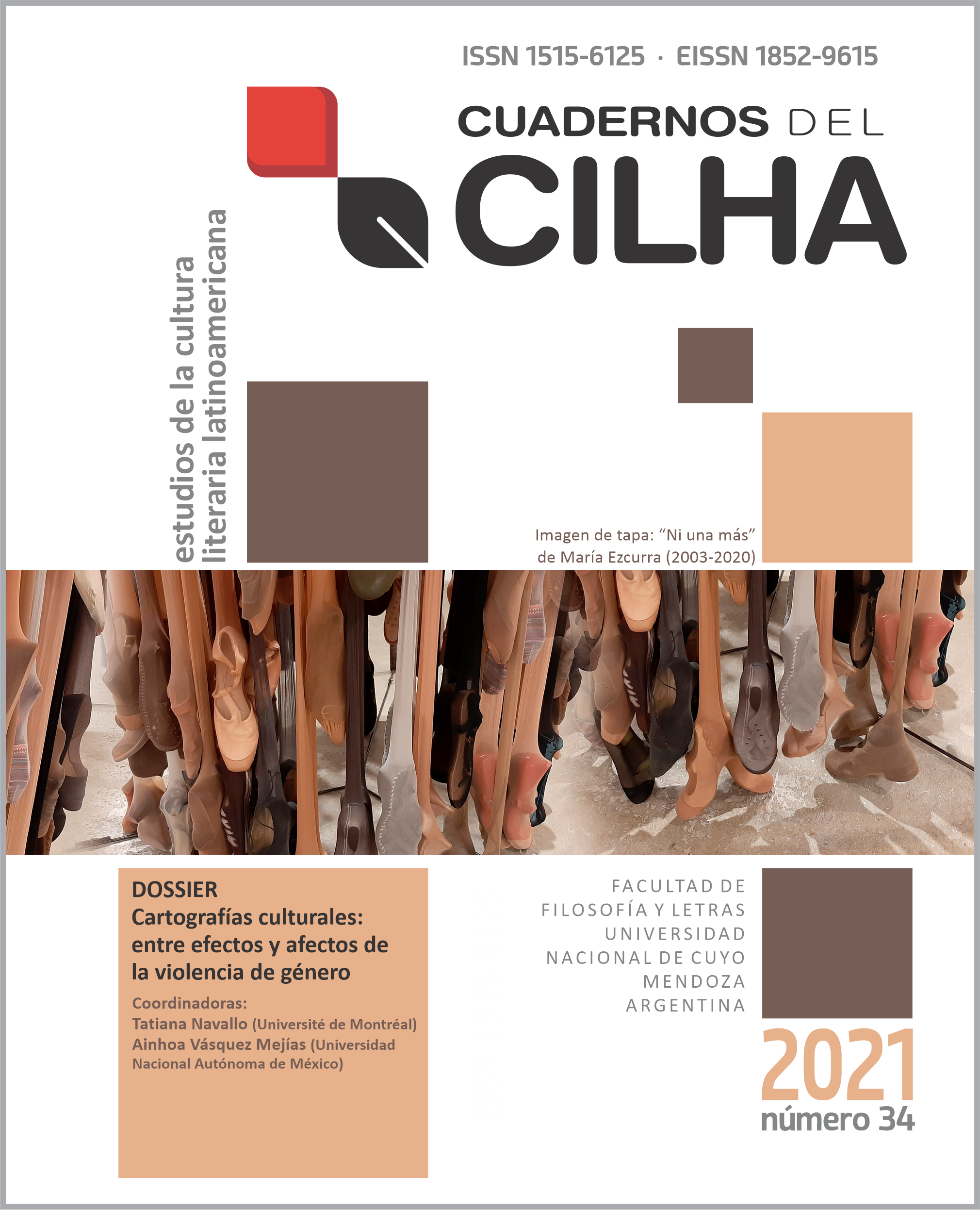From Family Crimes to State Crimes.
The Figure of the Mother in the Fight Against Gender Violence in The Crimes that Bind (2020) and The three deaths of Marisela Escobedo (2020)
DOI:
https://doi.org/10.48162/rev.34.005Keywords:
Argentina, Femicide, Mexico, Netflix, Gender violence.Abstract
The pressing problem of gender violence in Latin America has recently been addressed in the cinema of Argentina and Mexico. In this article we analyze two representations of this important topic in the films The Three Deaths of Maricela Escobedo by Carlos Pérez Osorio, and The Crimes that Bind Us by Sebastián Schindel. Based on real life stories, the directors use different strategies to visibilize and encourage discussion about the violence against women and its consequences. In The Crimes that Bind Us, Schindel sets the story in the drama genre and engages the spectator by proposing a narrative puzzle in which he introduces the topic, little by little, through elements of suspense. In The Three Deaths of Marisela Escobedo Pérez Osorio exposes through the use of documentary, the ordeal of a mother in search of justice for her daughter, victim of femicide. Through the emotional and social justice documentary, Pérez Osorio invigorates the debate around justice and gender violence. Our article analyzes the narrative strategies chosen by the directors to make visible and sharpen the debate around complex issues such as sexual assault, homicide aggravated by familial relationship and femicide. Second, we will focus on the construction of the perspective of the mother who conveys crucial issues such as awareness of gender violence, lack of justice, sorority and activism. Finally, we analyze the choice of both films to be co-produced and distributed by Netflix. We argue that the combinations of these three strategies contribute to form a “contra pedagogy of cruelty”, a term coined by Rita Segato.
References
Amado, A. M., & Domínguez, N. (2004). Lazos de familia: herencias, cuerpos, ficciones (vol. 13). Ediciones Paidos Iberica.
Arredondo, I. (2014). Motherhood in Mexican Cinema, 1941-1991. The Transformation of Femininity on Screen. McFarland & Company.
Arteaga, N., & Váldes, J. (2010). Contextos socioculturales de los feminicidios en el Estado de México: Nuevas subjetividades femeninas. Revista Mexicana de Sociología, 72(1), 5-35. http://www.jstor.org/stable/25677030
Aviña, R. (2014). Una mirada insólita. Temas y géneros del cine mexicano. Cineteca Nacional/ Oceano.
Baladrón, M., & Rivero, E. (2019). Video-on-demand services in Latin America: Trends and challenges towards access, concentration and regulation. Journal of Digital Media & Policy, 10 (1), 109–126. https://doi-org.proxy-sm.researchport.umd.edu/10.1386/jdmp.10.1.109_1
Bordwell, D., Thompson, Kristin. (2008). Film art: An introduction (Eight ed.). University of Wisconsin.
Burton J. (1990). The Social Documentary in Latin America. University of Pittsburgh Press.
Fregoso, R. L. (2009). “¡Las queremos vivas!”: la política y cultura de los derechos humanos. Debate Feminista, 39 (20), 209–243.
Convención Interamericana para prevenir, sancionar y erradicar la violencia contra la Mujer (6/9/1994). Convención De Belem Do Para. https://www.oas.org/juridico/spanish/firmas/a-61.html
Cornelio-Marí, E. M. (2020). Melodrama mexicano en la era de Netflix: algoritmos para la proximidad cultural. Comunicación y Sociedad, 17, 1–27. https://doi.org/10.32870/cys.v2020.7481
Incháustegui Romero, T. (2014). Sociología y política del feminicidio; algunas claves interpretativas a partir del caso mexicano. Sociedade e Estado, 29 (2), 373–400.
La casa del encuentro (2021). Feminismo popular entre todas las mujeres y con la sociedad. http://www.lacasadelencuentro.org/
La equipa editorial. (8 marzo 2020). #8M: Como nunca antes, una potente marcha de mujeres lanza grito contra el machismo y violencia feminicida. Animal politico. https://www.animalpolitico.com/2020/03/mujeres-marcha-8m-cdmx-protesta-machistmo/
Laudano, C. N. (2010). Visibilidad mediática de la violencia hacia las mujeres: continuidades y cambios en Argentina (1983-2009). Derecho y ciencias sociales, 88-110.
Ludmer, J. (2002). Temporalidades del presente. Margens/Márgenes: Revista de Cultura, (2), 14-27.
Lugones, M. (2007). Heterosexualism and the colonial/modern gender system. Hypatia, 22 (1), 186-219.
Lugones, M. (2008). Colonialidad y género. Tabula rasa, (09), 73-101.
Maradei, G. (2016). Cuerpos que inciden: Familia, matrimonio y maternidad en la literatura argentina de la última década. Chasqui, 45 (1), 246-263.
Mármol, H. (19 de febrero de 2020). 4.5 millones de usuarios Argentina está entre los 10 países con más suscriptores de Netflix. Clarín Tecnología. https://www.clarin.com/tecnologia/argentina-10-paises-suscriptores-netflix-mundo_0_gqaLXSjU.html
Ministerio de Cultura Argentina. (22 de agosto de 2020). Crímenes de familia, la última película de Sebastian Schindel, disponible en Cine.AR. https://www.cultura.gob.ar/entrevista-sebastian-schindel-9398/
Monárrez, J. (1993). Las diversas representaciones del feminicidio y los asesinatos de mujeres en Ciudad Juárez. En M. Fragoso, C. Gómez, F. Flores, M. César y R. Salar (eds), Violencia contra las mujeres e inseguridad ciudadana en Ciudad Juárez (pp. 353-398). El Colef, Miguel Ángel Porrúa.
ONU Mujeres. (25 de noviembre de 2018). La violencia contra las mujeres no es normal ni tolerable. Garantizar los derechos humanos de las mujeres y las niñas es trabajo de todas y de todos. https://mexico.unwomen.org/es/noticias-y-eventos/articulos/2018/11/violencia-contra-las-mujeres
OM. Oficina de la Mujer (29 de mayo de 2021) Registro Nacional de Femicidios: “Se cometió un femicidio directo cada 35 horas”. https://www.csjn.gov.ar/om/verNoticia.do?idNoticia=4943
Orozco Mendoza, E. F. (2019). Las Madres De Chihuahua: Maternal Activism, Public Disclosure, and the Politics of Visibility. New Political Science, 41 (2), 211–233.
Pagnoni Berns, F. G. (2016). Motherhood and Identity in Contemporary Argentine Cinema. In A. Sayed (ed.), Screening motherhood in contemporary world cinema (pps. 365-389). Demeter Press.
Palmeiro, C. (2019). Ni Una Menos: las lenguas locas del grito colectivo a la marea global. Cuadernos de Literatura, 23 (46), 177-195.
Pereda Martínez, A. (29 de mayo 2019). Asesinatos de mujeres, un delito que va al alza. El Universal. https://www.eluniversal.com.mx/estados/cada-dos-horas-y-media-matan-una-mujer-en-mexico
Pérez Osorio, C. (Director) (2020). Las tres muertes de Marisela Escobedo. Netflix Studios.
Santos, C. (2016). Maligned Mothers: From Coatlicue to La Malinche and back. In A. Sayed (ed.), Screening motherhood in contemporary world cinema. Demeter Press.
Sayed, A. (2016). Intersectional Interventions in Global Cinema. Introducing the maternal. In A. Sayed (ed.), Screening motherhood in contemporary world cinema (pps. 34-37). Demeter Press.
Segato, R. (2003). Las estructuras elementales de la violencia: contrato y status en la etiología de la violencia. Série Antropologia, 334, 1-19.
Segato, R. (2008). La escritura en el cuerpo de las mujeres asesinadas en Ciudad Juárez: territorio, soberanía y crímenes de segundo estado. Debate Feminista, 37 (19), 78–102.
Segato, R. (2018). A Manifesto in Four Themes. Critical Times, 1 (1), 198-211.
Segato, R. (4 de enero de 2021). Crueldad: Pedagogías y Contra-Pedagogías. Lobo Suelto Anarquia Coronada http://lobosuelto.com/crueldad-pedagogias-y-contra-pedagogias-rita-segato/
Schindel, S. (dir.). (2020). Crímenes de familia [Film]. Buffalo Films, Magoya Films, Tieless Media.
Tiscareño García, E., & Miranda Villanueva, O. M. (2020). Víctimas y victimarios de feminicidio en el lenguaje de la prensa escrita mexicana. Comunicar, Revista Científica iberoamericana de comunicación y educación, 63, 51-60. https://doi-org.proxy-sm.researchport.umd.edu/10.3916/C63-2020-05
Tuñón J. (1998). Mujeres de luz y sombra en el cine mexicano: La construcción de una imagen (1939–1952). El Colegio de México/Instituto Mexicano de Cinematografía.
Yanal, Robert J. (1996). The Paradox of Suspense. The British Journal of Aesthetics, 36 (2), 146-158.
Wilson, T. (2014). Introduction: Violence against Women in Latin America. Latin American Perspectives, 41 (1), 3-18. http://www.jstor.org/stable/24573973
Downloads
Published
Versions
- 27-06-2021 (2)
- 27-06-2021 (1)





















